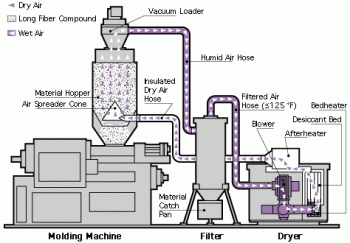Long Fiber Compounds Molding Guidelines
Moisture may be present in some materials, either on the surface or absorbed by the resin system. Without proper drying, this moisture may be converted to steam in the injection cylinder and cause blisters, splay, internal voids, and lamination of the molded part’s surface. Undried hygroscopic materials can suffer degradation of properties.
Typical Dehumidifying Closed System for Drying Long Fiber Compounds

In the hopper, the drying units force hot dehumidified air through the plastic granule by way of a closed air circulating system. The moisture is removed by the sieve desiccant, which traps the moisture molecules. The dry air is then heated to a preset temperature and delivered to the material in the insulated hopper.
The majority of water is absorbed in the initial contact with the desiccant bed. When the bed becomes saturated, it is regenerated by heating to more than 500 degrees F (290 degrees C), purging itself of moisture. Properly maintained dryer systems give consistently dry resin, higher yields, and improved stream time, which can yield greater profits. Desiccants should be replaced every two years, and dryer filters should be checked and cleaned once each shift to insure adequate air flow to the bed.
Regrind
Regrind materials may be used to a maximum level of 5% without significantly changing Long Fiber Compound properties. Higher percentages reduce average fiber length, negatively affecting impact resistance and other structural properties. Accurately mix ground runners, sprue, and rejects with the virgin pellets, being careful to keep the mixture free of contamination.




